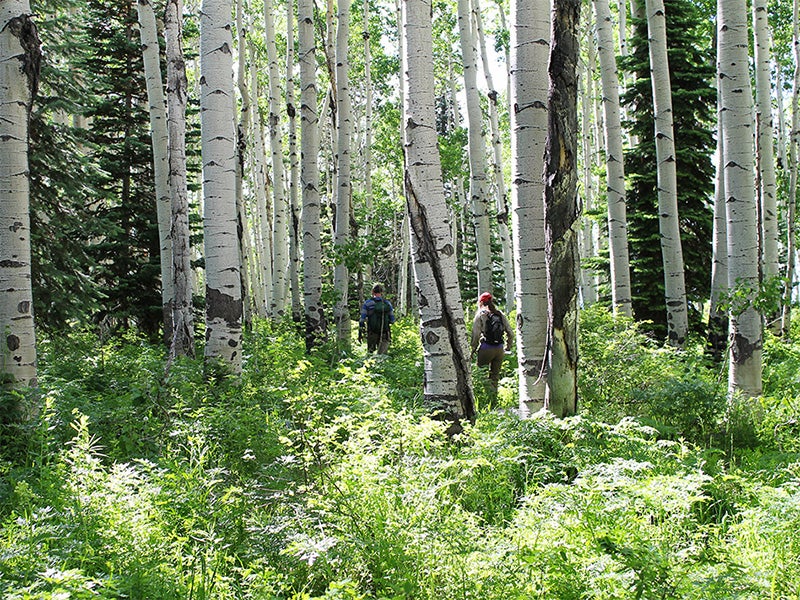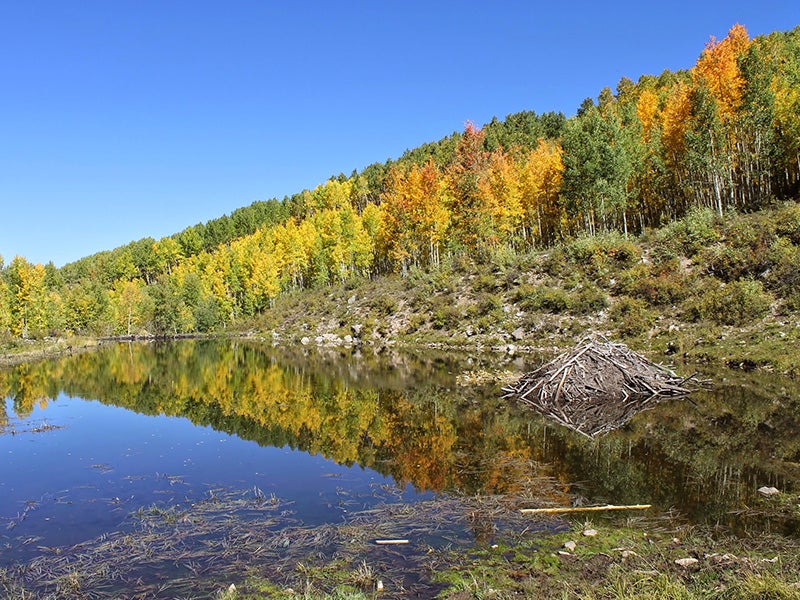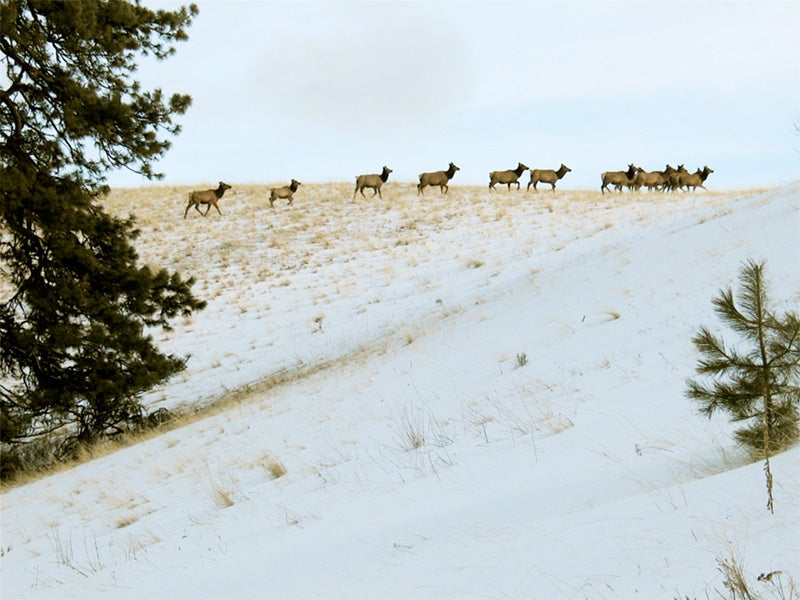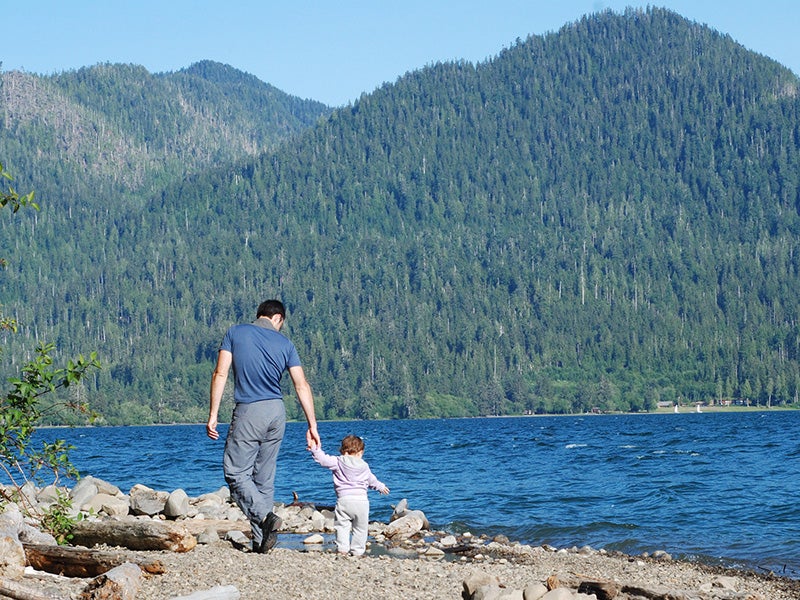August 27, 2025
Timeline of the Roadless Rule
About the creation of the National Forest Roadless Area Conservation Policy and the decades-long legal fight to defend it


Aspens and beaver lodge in Sunset Roadless Area, Colorado. (Ted Zukoski / Earthjustice)


Top: Aspens and beaver lodge in Sunset Roadless Area, Colorado. (Ted Zukoski / Earthjustice) Bottom Left: Rapid River Roadless area in Idaho’s Nez Perce National Forest. (John McCarthy / The Wilderness Society) Bottom Right: South Ridge Quinault Roadless Area, Olympic National Forest, Washington. (Wild Trees / CC BY-NC-ND 2.0)
The nearly 50 million acres of roadless areas in our national forests are an American treasure.
The forests protected by the 2001 Roadless Rule — adopted with overwhelming public support — provide vital habitat for thousands of wildlife species, safeguard drinking water supplies for millions of Americans, and ensure quality recreation cherished by all. See recent news on the Roadless Rule.
* January
Forest Service Chief Michael Dombeck announces he will be developing a transportation policy for the National Forest System.
He also proposes to institute an 18-month road building moratorium on 130 National Forests while that policy is developed.
February
A temporary roadbuilding moratorium approved by the Forest Service goes into effect.
The Wyoming Timber Industry Association promptly challenges the moratorium in Federal District Court. Earthjustice intervenes in that case on behalf of the government and conservationists.
A second case challenging the Forest Service's efforts to protect roadless areas is brought by the State of Idaho.
October
President Clinton announces his administration will develop a more comprehensive policy to protect the remaining unprotected wilderness areas in the National Forest System. This effort will be conducted on a separate track from the previously announced transportation policy, which would primarily focus on areas within the National Forests that are already roaded.
January
The Wyoming Timber Industry Association's challenge is dismissed.
February
Idaho's lawsuit is dismissed as premature.
May
The Forest Service releases a Draft Environmental Impact Statement to implement President Clinton's plan. Under the proposed policy, 43 million acres of roadless forest would be protected. The policy marks an important first step towards the preservation of our national forests, but it does not go far enough.
November 13
The Forest Service releases a near-final plan. The agency proposes to immediately prohibit roadbuilding and commodity logging on 49 million acres of wild forests. In 2004, it would be expanded to include Alaska's Tongass National Forest, bringing the total acres protected to 58.5 million. Earthjustice works to ensure that the final plan protects the Tongass.
* January
President Clinton issues the Roadless Area Conservation Policy directive, ending virtually all logging; roadbuilding; and coal, gas, oil, and other mineral leasing in 58 million acres of the wildest remaining undeveloped national forests lands.
The Rule is the direct result of a tremendous outpouring of public support. More than 600 public hearings were held around the nation, and the public provided more than 1.6 million comments on the Rule—more comments than any other rule in the nation's history.
January 12
The Roadless policy rule is published in the Federal Register.
* January 20, 2001
George W. Bush is sworn in as the 43rd President.
The new White House Chief of Staff, Andrew Card, sends a memo from the White House in late January, telling all Cabinet Secretaries to delay rules and regulations pushed into place during the final days of the Clinton administration. The Roadless Rule is one of many new policies that fall under this description.
February 5
In accordance with President Bush's Regulatory Review Plan, the roadless policy is delayed for an additional 60 calendar days. This is the result of the so-called "Card Memo" from White House Chief of Staff Andrew Card.
March 16
The administration delays the rule a second time. In response to a court challenge seeking to overturn the new rule filed by Boise Cascade Company, the State of Idaho, and others, the U.S. Justice Department "committed to postponing" implementation of the policy yet again.
Agriculture Secretary Ann Veneman publishes an official notice in the Federal Register, noting that the implementation date of the Roadless Rule is being delayed an additional 60 days, from March 13 to May 12.
Usually a rule will take affect 60 days after it is published in the Federal Register. After it takes affect, it is law and can only be overturned by either an act of Congress or an official new rulemaking process.
Unfortunately, since it caught the Roadless Rule in this 60-day window, the Bush administration could legally delay the Roadless Rule from going into effect.
March 30
The government commits to completing its review of the rule, and says it will report back to the court in Boise on May 4.
May 4
The government reports they will allow the Roadless Rule to go into effect on May 12, but would move at a later date to amend it.
* May 10, 2001
Idaho Federal Judge Edward Lodge issues a preliminary injunction barring the Rule from taking affect.
October 15
Earthjustice attorneys present oral arguments in defense of the Roadless Rule before the Ninth Circuit Court of Appeals in Seattle. A three-judge panel hears attorney Doug Honnold argue for a lifting of the injunction currently keeping the rule from being implemented.
Summer
Legislation is introduced in the House and Senate to legislatively authorize the Roadless Rule.
August
The government defends the Roadless Rule in a surprise reversal. The goverment's brief was filed in another challenge to the Roadless Rule filed by the state of North Dakota and is the first real defense of the rule by the federal government.
In this case, the government finally admits the Roadless Rule was legally adopted.
* December 12, 2002
The Ninth Circuit Court of Appeals reinstates the Roadless Area Conservation Rule by reversing the injunction of Judge Lodge.
June 9
The administration announces it will settle a lawsuit brought by the State of Alaska by agreeing to exempt the Tongass National Forest—and later the Chugach National Forest—from the Roadless Rule.
The administration also said it was working on a revised rule that would allow governors to opt out of the rule.
* July 14, 2003
Wyoming Federal Court Judge Clarence Brimmer finds the Rule illegal and issues an injunction that purports to cover the entire country. That ruling is appealed by intervenors represented by Earthjustice. It is not appealed by the government defendants.
* December 30, 2003
The administration formally settles the Alaska case and "temporarily" exempts the Tongass National Forest from the Roadless Rule.
May 11
The Tenth Circuit Court of Appeals agrees to hear the intervenors' appeal of the Wyoming injunction—the administration had urged the court to dismiss the appeal.
July 12
The Bush administration proposes a new Rule to replace the 2001 Rule "with a petitioning process that would allow Governors an opportunity to seek establishment of management requirements for National Forest System inventoried roadless areas within their States." The proposed Rule is praised by timber companies and universally derided by environmental organizations.
* May 5
The Bush administration puts the state petitions rule into place as a substitute for the Roadless Rule.
May 12
The administration formally adopts the new Rule with an announcement in the Federal Register.
June 8
Earthjustice Attorney Kristen Boyles sends a letter to the Forest Service notifying the agency that it has violated the Endangered Species Act by failing to consult with the Fish & Wildlife Service and the National Marine Fisheries Service prior to putting the new Roadless Rule into effect.
July 11
The Tenth Circuit Court of Appeals dismisses the appeal of the Wyoming injunction on the grounds that the new Rule made the case moot. The court did, however, erase the Wyoming court's ruling.
July 28
146 members of the House of Representatives introduce legislation that will reinstate the original Roadless Rule and repeal the Bush administration's substitute.
August 30
The attorneys general of California and New Mexico and the governor of Oregon file suit, challenging the Bush administration's substitute Roadless Rule and seeking reinstatement of the original Rule.
* October 6, 2005
20 conservation groups—represented by Earthjustice—file a lawsuit in federal district court in San Francisco seeking to reinstate the original Roadless Rule. The case is similar to but somewhat broader than the one filed by the three states.
December 22
Virginia becomes the first state to file a petition under the Bush Rule, seeking protection for all roadless areas in the state.
February 2
The State of Washington moves to join the lawsuit filed by California, New Mexico, and Oregon on the side of those states.
February 15
Idaho roadless supporters castigate Governor Dirk Kempthorne for hiring timber industry lobbyists to summarize public comments on the roadless petition process.
February 22
The BlueRibbon Coalition and other anti-roadless organization move to intervene in litigation filed by states and environmental groups.
February 24
The States of Montana and Maine file friend-of-the-court briefs in support of California, Oregon, New Mexico, and Washington.
March 2
Environmental groups submit petitions signed by 265,000 people urging the Bush administration to reinstate the original Roadless Rule. The same day, Senator Maria Cantwell and Representative Jay Inslee submit a bill in Congress seeking to codify the original Roadless Rule as law.
March 9
North Carolina Governor Mark Easley petitions the Bush administration to protect all roadless areas in his state.
April 5
The Nez Perce Tribe petitions the Secretary of Agriculture to reinstate the Roadless Rule in order to protect tribal lands and traditional use territories.
April 19
South Carolina Governor Mark Sanford files a petition to protect roadless forest lands in that state.
May 22
The Roadless Area Conservation National Advisory Committee reviews the first of three petitions by Virginia, North Carolina, and South Carolina asking for provisions of the 2001 Rule be reinstated for their forests.
June 1
New Mexico Governor Bill Richardson petitions the Bush administration to protect all of his state's roadless forests, becoming the first Western Governor to do so.
June 10
Oregon Gov. Ted Kulongoski announces he will seek a temporary restraining order to stop the Forest Service from moving forward with logging Oregon's largest unprotected roadless forest area.
June 21
The Bush administration approves requests from the governors of three Eastern states—Virginia, North Carolina, and South Carolina—to protect 555,000 acres of roadless forests within their borders.
July 12
California Governor Arnold Schwarzenegger files a petition seeking protection for all of California's roadless national forests—more than four million acres.
Early August
The Silver Creek Timber Company starts cutting down trees in an Oregon roadless area, despite objections from Governor Ted Kulongoski.
August 10
The Bureau of Land Management auctions 20,000 acres of land in inventoried roadless areas in Colorado to companies that will explore them for possible oil and gas deposits, over objections from Senator Ken Salazar (D-CO).
* September 20, 2006
Federal District Court Judge Elizabeth Laporte in San Francisco orders reinstatement of the Clinton-era Roadless Rule to protect almost 50 million acres of wild national forests and grasslands from road building, logging, and development.
Idaho Governor Jim Risch is the first to file a petition opposing most protections for roadless areas in his state, potentially affecting up to 9.3 million acres of roadless federal forests in Idaho.
November 13
Colorado Governor Bill Owens submits the second state petition on the management of roadless areas in his state.
February 6
Judge Laporte issues a final injunction, clarifying that the injunction extends to oil and gas drilling permits (as well as leases) issued since May 2005.
April 9
The Forest Service and timber industry appeal Judge Laporte's decision to the Ninth Circuit.
Parties in Tongass National Forest litigation reach a "global settlement" that protects all roadless areas, pending revision of Tongass forest plan.
April 10
Federal Register notice initiates 30-day scoping comment period on Idaho petition for state-specific rulemaking.
April 11
Colorado Governor Ritter submits roadless petition including exemptions for ski areas, grazing, and coal mining.
May 24
Bills to enact the Roadless Rule are introduced in the House and Senate.
June 7
Judge Brimmer denies State of Wyoming's request to reinstate his 2003 decision enjoining the Roadless Rule.
July 5
The Tenth Circuit Court of Appeals denies State of Wyoming's request to reinstate intervenors' appeal of Judge Brimmer's 2003 case.
October 19
Judge Brimmer holds oral arguments on State of Wyoming's new lawsuit challenging the 2001 Roadless Rule.
December 20
Idaho Roadless Rule draft EIS is released.
January 22
10-year anniversary of the Forest Service's proposed moratorium on road construction in Inventoried Roadless Areas.
January 25
The Tongass final forest plan is released.
February 28
The State of California sues the Forest Service for failing to protect roadless areas in four southern California forest plans.
July 25
The draft rule for Colorado roadless areas is released for 90 days of public comment.
* August 12, 2008
Wyoming Federal District Court Judge Brimmer issues a second decision, very similar to the July 14, 2003 decision, invalidating and enjoining the Roadless Rule nationwide.
August 20
The Bush administration asks Judge Brimmer and Judge Laporte to suspend their respective injunctions.
August 29
The Final EIS on the Idaho Roadless Rule is released.
September 12
Earthjustice attorneys file a challenge to an expansion of the Smoky Canyon phosphate mine in Idaho—an expansion into two roadless areas.
* October 16, 2008
The Forest Service adopts the less-protective Idaho Roadless Rule.
October 20
Ninth Circuit hearing on Administration's appeal of Judge Laporte's September 20, 2006 decision.
November 4
Barack Obama, a supporter of the Roadless Rule, is elected President of the United States.
November 26
The district court denies Earthjustice's motion for a preliminary injunction in the Smoky Canyon phosphate mine case.
December 2
Judge Laporte partially stays her injunction, limiting geographic scope to the Ninth Circuit and New Mexico.
December 5
Colorado and Administration officials agree to postpone finalizing the Colorado Roadless Rule until spring 2009.
January 28
Earthjustice attorneys challenge the Idaho Roadless Rule in federal court.
March 18
25 U.S. Senators and 131 Representatives send letters to USDA Secretary Vilsack requesting interim protection of all roadless areas.
April 10
The Ninth Circuit Court of Appeals stops expansion of the phosphate mine into the Smoky Canyon Roadless Area in Idaho.
May 13
A district court judge ignores the Ninth Circuit and gives the phosphate mine owner permission to resume expansion into the roadless area.
May 21
The Ninth Circuit issues an emergency stay halting expansion of the Smoky Canyon phosphate mine until it can rule on the appeal of the judge's earlier order.
May 28
The Obama administration announces that Agriculture Secretary Tom Vilsack will review all plans for roadbuilding or logging in designated roadless areas for at least the next year. The review does not automatically stop upcoming timber sales in the Tongass, and excludes all of Idaho.
July 13
Secretary Vilsack approves the awarding of a contract for the Orion North timber sale in the Tongass National Forest, making it the first roadless timber sale authorized since the Secretary issued an interim directive providing that he would review all decisions allowing logging in roadless areas of our national forests.
* August 5, 2009
The Ninth Circuit Court of Appeals affirms protection for over 40 million acres of wild national forests and grasslands from new road building, logging, and development.
August 13
The Obama administration appeals a Wyoming federal district court ruling that struck down the national Roadless Rule. The appeal will go to the Tenth Circuit Court of Appeals in Denver.
December 22
Earthjustice attorney Tom Waldo and co-counsel from the Natural Resources Defense Council file a lawsuit seeking to end the 2003 Bush-era decision to "temporarily" exempt the Tongass from the Roadless Rule.
May 28
The Tongass is granted another year's reprieve after the Obama administration extends a moratorium on most logging and mining development.
January 29
Idaho District Court upholds the Idaho Roadless Rule.
* March 4, 2011
Alaska District Court vacates the 2003 Tongass exemption and reinstates the Roadless Rule on the Tongass.
June 20
The State of Alaska challenges the application of the Roadless Rule to National Forests in Alaska.
* October 21, 2011
The Tenth Circuit Court of Appeals reverses Wyoming district court, upholding the Roadless Rule and vacating the prior injunction.
Feburary 16
The Tenth Circuit Court of Appeals rejects a request from the State of Wyoming and the Colorado Mining Association asking for another hearing on their case against the Roadless Rule.
* October 1, 2012
The U.S. Supreme Court denies a request by the State of Wyoming to review the legality of the Roadless Rule.
Of the decision, attorney Kristen Boyles says: "With the Supreme Court's denial of Wyoming's petition for review, there should no longer be any question about the Roadless Rule’s legality."
* March 25
The D.C. District Court ends a challenge by the state of Alaska against the Roadless Rule.
The case is the final litigation challenging the rule nationwide. The court holds that no further challenges are allowed, because the statute of limitations has run out.
March 26
A divided panel of the Ninth Circuit Court of Appeals reverses the 2011 Alaska District Court decision by a 2–1 split vote, once again exempting the Tongass from the Roadless Rule's protection.
August 29
The U.S. Court of Appeals for the Ninth Circuit announces it will re-hear the case challenging the Tongass exemption. The court grants the rehearing en banc, rendering the earlier opinion ineffective.
* July 29
The Ninth Circuit's 11-judge en banc panel rules that the exemption of the Tongass from the Roadless Rule was illegal.
March 28
The U.S. Supreme Court declines to hear a last-ditch effort by the State of Alaska to exempt the Tongass National Forest from the Roadless Rule.
The Ninth Circuit's ruling—and the decision by the Supreme Court not to review that ruling—reinforced the settled rule that federal agencies cannot arbitrarily change policies and ignore previous factual findings simply because a new president has taken office.
* September 21
The U.S. District Court for the District of Columbia throws out the state of Alaska’s attack on protections for the nearly 50 million acres of wild “roadless” national forest lands nationwide from logging and logging roads.
The U.S. District Court for the District of Columbia previously dismissed the case for exceeding the six-year statute of limitations. An appeals court overturned that ruling, saying the clock started ticking when a federal court reinstated the rule in 2006, not when the rule was first issued in 2001. Alaska filed its challenge in 2011, seeking to overturn the rule on multiple grounds. The lengthy and careful ruling finds that each of those claims lack merit.
Groups intervening in Alaska’s case to defend the Roadless Rule included Southeast Alaska Conservation Council, Alaska Center for the Environment, The Boat Company, Natural Resources Defense Council (NRDC), Sierra Club, The Wilderness Society, Defenders of Wildlife, Tongass Conservation Society, Center for Biological Diversity, and Greenpeace. The groups are represented by attorneys from Earthjustice and NRDC.
August 2
The U.S. Department of Agriculture announces that it intends to create an “Alaska state-specific” version of the Roadless Rule, undermining safeguards for the Tongass and the Chugach National Forests, prized expanses of glaciers, fjords and old-growth rainforest spanning more than 22 million acres in Alaska.
October 15
The U.S. Forest Service announces plans to repeal Roadless Rule protections across more than 9 million acres of the Tongass National Forest, enabling logging interests to bulldoze roads and clear-cut trees in areas of the Tongass that have been off-limits for decades.
“The millions of ancient trees across this temperate rainforest serve as the greatest carbon sanctuary in the U.S. national forest system, helping us all as a counterweight against the climate crisis,” said Earthjustice Managing Attorney Eric Jorgensen. “Earthjustice will oppose this attack on the safeguards wisely established by the Roadless Rule.”
October 29
The Trump administration announces a final rule exempting the Tongass National Forest from the Roadless Rule.
* December 23, 2020
Earthjustice and co-counsel Natural Resources Defense Council filed a lawsuit in federal court on behalf of five Alaska Native Tribes, Southeast Alaska small businesses, and conservation organizations, challenging the Trump administration's decision to exempt the Tongass National Forest from the Roadless Rule.
“This lawsuit is a direct response to the outgoing administration’s attempt to open Alaska’s Tongass National Forest to a new round of devastating clear-cuts in some of the most important remaining old-growth habitat in the forest,” explained Earthjustice attorney Kate Glover.
January 20
President Biden directed USDA to review the Tongass Roadless decision, among other rules, in a first day executive order.
June 11
The U.S. Forest Service, under the Biden administration, announces a timeline for revisting the first Trump administration’s rollback of federal Roadless Rule protections that exempted Southeast Alaska’s Tongass National Forest.
July 15
The U.S. Department of Agriculture announces the Southeast Alaska Sustainability Strategy, a new strategy for the Tongass National Forest intended to improve engagement with tribal nations, end large-scale old growth timber sales on the Tongass National Forest, restore the Roadless Rule to the Tongass, and shift management resources to supporting forest restoration, recreation and resilience, including for climate, wildlife habitat and watershed improvement.
The USDA pledges to consult with Tribes and Alaska Native corporations, and to invest approximately $25 million to work collaboratively with partners and communities to build sustainable opportunities for economic growth and community well-being.
November 16
The D.C. Circuit Court of Appeals dismissed Alaska’s attack on the Roadless Rule, holding the case moot because the Trump administration had already granted Alaska’s petition to exempt the Tongass.
November 23
The U.S. Forest Service formally announces a proposal to restore Roadless Rule protections in Alaska’s Tongass National Forest and initiates a comment period.
* January 27
The U.S. Forest Service formally reinstates the Roadless Rule protections across the Tongass National Forest, restoring protection to 9.2 million acres of land.
In March 2023, following the reinstatement, the December 2020 lawsuit challenging the first Trump administration’s Tongass exemption is dismissed.
September 8
The State of Alaska, two power companies and a coalition of business and industry supporters file three separate lawsuits asking a federal court in Alaska to overturn the 2023 protections in favor of the 2020 Trump-era Roadless Rule excluding the Tongass.
* January 30
A broad coalition of Alaska Native Tribes, commercial fishing advocates, small tourism businesses, conservation groups, and other forest advocates seek to defend the 2023 reinstatement of National Roadless Rule protections across the Tongass National Forest in Southeast Alaska by intervening in the legal challenges filed in September 2023 opposing the rule.
That litigation is currently on pause [as of June 2025] and is expected to be dismissed once the Trump administration moves to repeal Roadless Rule protections for the Tongass.
January 20
On his first day in office, President Trump signed the Executive Order, “Unleashing Alaska's Extraordinary Resource Potential,” which outlines plans for maximum exploitation of Alaska’s natural resources including repealing Roadless Rule protections for the Tongass.
June 23
Agriculture Secretary Rollins announced a rollback of the 2001 Roadless Rule. The move is particularly significant for the Tongass National Forest, where eliminating the Roadless Rule would remove critical safeguards against industrial logging and damaging roadbuilding from over 9 million undeveloped acres within the 17-million-acre forest.
While the Trump administration has suggested that wildfire risk is an underlying reason for these sweeping policy changes, rolling back the Roadless Rule actually threatens to cause more fires.
* August 27
The U.S. Department of Agriculture began the process to repeal the Roadless Rule.
The public has just three weeks, until September 19, to comment on this first step in the Forest Service’s process to rescind the Roadless Rule.
“Earthjustice has successfully defended the Roadless Rule in court for decades,” said Drew Caputo, Vice President of Litigation for Lands, Wildlife and Oceans at Earthjustice. “Nothing will stop us from taking up that fight again.”
Timeline Last Updated: Dec. 23, 2020